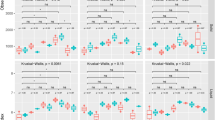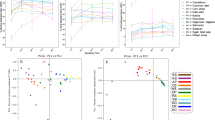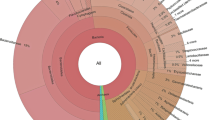Abstract
Rumen microbial community harbors a distinct genetic reservoir of potent carbohydrate-active enzymes (CAZyme) that functions efficiently for the deconstruction of plant biomass. Based on this premise, metagenomics approach was applied to characterize the rumen microbial community and identify carbohydrate-active genes of Bos taurus (cow) and Bubalus bubalis (buffalo) fed on green or dry roughage. Metadata was generated from the samples: green roughage-fed cow (NDC_GR), buffalo (NDB_GR) and dry roughage-fed cow (NDC_DR), buffalo (NDB_DR). Phylogenetic analysis revealed the dominance of Bacteroidetes, Firmicutes, Proteobacteria, Actinobacteria and Fibrobacter in all the four samples, covering 90–96% of the total bacterial population. On finer resolution, higher abundance of bacterial genera Fibrobacter, Bacteroides, Clostridium, Prevotella and Ruminococcus involved in plant biomass hydrolysis was observed in NDB_DR. Functional annotation using dbCAN annotation algorithm identified 28.13%, 8.08% 10.93% and 12.53% of the total contigs as putatively carbohydrate-active against NDC_GR, NDB_GR, NDC_DR and NDB_DR, respectively. Additional profiling of CAZymes revealed an over representation and diversity of putative glycoside hydrolases (GHs) in the animals fed on dry roughage with substantial enrichments of genes encoding GHs from families GH2, GH3, GH13 and GH43. GHs of families GH45, GH12, GH113, GH128, GH54 and GH27 were observed exclusively in NDB_DR metagenome. A higher abundance of cellulases, hemicellulases, debranching and oligosaccharide hydrolyzing enzymes was revealed in NDB_DR metagenome. Accordingly, it can be concluded that buffalo rumen microbiome are more efficient in plant biomass hydrolysis. The present study provides a deep understanding of the shifts in microbial community and plant polysaccharide deconstructing capabilities of rumen microbiome in response to changes in the feed type and host animal. Activity-specific microbial consortia procured from these animals can be used further for efficient plant biomass hydrolysis. The study also establishes the utility of rumen microbiome as a unique resource for mining diverse lignocellulolytic enzymes.





Similar content being viewed by others
References
Aggarwal NK, Goyal V, Saini A, Yadav A, Gupta R (2017) Enzymatic saccharification of pretreated rice straw by cellulases from Aspergillus niger BK01. 3 Biotech 7(3):158. https://doi.org/10.1007/s13205-017-0755-0
Alvira P, Tomás-Pejó E, Ballesteros MJ, Negro MJ (2010) Pretreatment technologies for an efficient bioethanol production process based on enzymatic hydrolysis: a review. Bioresour Technol 101:4851–4861. https://doi.org/10.1016/j.biortech.2009.11.093
Artzi L, Dadosh T, Milrot E, Moraïs S, Levin-Zaidman S, Morag E, Bayer EA (2018) Colocalization and disposition of cellulosomes in Clostridium clariflavum as revealed by correlative super resolution imaging. MBio 9(1):e00012–18. https://doi.org/10.1128/mBio.00012-18
Bernardes A, Pellegrini VOA, Curtolo F, Camilo CM, Mello BL, Johns MA, Scott JL, Guimaraes FEC, Polikarpov I (2019) Carbohydrate binding modules enhance cellulose enzymatic hydrolysis by increasing access of cellulases to the substrate. Carbohydr Polym 211:57–68. https://doi.org/10.1016/j.carbpol.2019.01.108
Bertucci M, Calusinska M, Goux X, Rouland-Lefèvre C, Untereiner B, Ferrer P, Gerin PA, Delfosse P (2019) Carbohydrate hydrolytic potential and redundancy of anaerobic digestion microbiome exposed to acidosis uncovered by metagenomics. Appl Environ Microbiol 15:9. https://doi.org/10.1128/AEM.00895-19
Biddle A, Stewart L, Blanchard J, Leschine S (2013) Untangling the genetic basis of fibrolytic specialization by Lachnospiraceae and Ruminococcaceae in diverse gut communities. Diversity. 5:627–640. https://doi.org/10.3390/d5030627
Bohra V, Dafale NA, Purohit HJ (2018) Paenibacillus polymyxa ND25: candidate genome for lignocellulosic biomass utilization. 3 Biotech 8:248. https://doi.org/10.1007/s13205-018-1274-3
Bohra V, Dafale NA, Hathi Z, Purohit HJ (2019a) Genomic annotation and validation of bacterial consortium NDMC-1 for enhanced degradation of sugarcane bagasse. Ann Microbiol. https://doi.org/10.1007/s13213-019-01462-x
Bohra V, Dafale NA, Tikariha H (2019b) Genomically defined Paenibacillus polymyxa ND24 for efficient cellulase production utilizing sugarcane bagasse as a substrate. Appl Biochem Biotechnol 187:266–281. https://doi.org/10.1007/s12010-018-2820-5
Brulc JM, Antonopoulos DA, Miller ME, Wilson MK, Yannarell AC, Dinsdale EA, Edwards RE, Frank ED, Emerson JB, Wacklin P, Coutinho PM, Henrissat B, Nelson KE, White BA (2009) Gene-centric metagenomics of the fiber-adherent bovine rumen microbiome reveals forage specific glycoside hydrolases. Proc Natl Acad Sci USA 106:1948–1953. https://doi.org/10.1073/pnas.0806191105
Cantarel BL, Coutinho PM, Rancurel C, Bernard T, Lombard V, Henris-sat B (2009) The carbohydrate-active enzymes database (CAZy): an expert resource for glycogenomics. Nucleic Acids Res 37:D233–D238. https://doi.org/10.1093/nar/gkn663
Chanthakhoun V, Wanapat M, Kongmun P, Cherdthong A (2012) Comparison of ruminal fermentation characteristics and microbial population in swamp buffalo and cattle. Livest Sci 143:172–176. https://doi.org/10.1016/j.livsci.2011.09.009
Dai X, Zhu Y, Luo Y, Song L, Liu D, Liu L, Chen F, Wang M, Li J, Zeng X, Dong Z (2012) Metagenomic insights into the fibrolytic microbiome in yak rumen. PLoS One 7(7):e40430. https://doi.org/10.1371/journal.pone.0040430
Do TH, Le NG, Dao TK, Nguyen TMP, Le TL, Luu HL, Nguyen KHV, Van LN, Le LA, Phung TN, Van Straalen NM (2018) Metagenomic insights into lignocellulose-degrading genes through Illumina-based de novo sequencing of the microbiome in Vietnamese native goats’ rumen. J Gen Appl Microbiol 64(3):108–116. https://doi.org/10.2323/jgam.2017.08.004
Du L, Ma L, Ma Q, Guo G, Han X, Xiao D (2018) Hydrolytic boosting of lignocellulosic biomass by a fungal lytic polysaccharide monooxygenase, AnLPMO15 g from Aspergillus niger. Ind Crops Prod 126:309–315. https://doi.org/10.1016/j.indcrop.2018.10.029
Flint HJ, Scott KP, Louis P, Duncan SH (2012) The role of the gut microbiota in nutrition and health. Nat Rev Gastroenterol Hepatol 9:577–589. https://doi.org/10.1038/nrgastro.2012.156
Henderson G, Cox F, Ganesh S, Jonker A, Young W, Abecia L, Angarita E, Aravena P, Arenas GN, Ariza C, Collaborators GRC (2015) Rumen microbial community composition varies with diet and host, but a core microbiome is found across a wide geographical range. Sci Rep 5:14567. https://doi.org/10.1038/srep14567
Hess M, Sczyrba A, Egan R, Kim TW, Chokhawala H, Schroth G, Luo S, Clark DS, Chen F, Zhang T, Mackie RI (2011) Metagenomic discovery of biomass degrading genes and genomes from cow rumen. Science 331:463–467. https://doi.org/10.1126/science.1200387
Hoffmann R, Kovacs B (2011) Compare to different green roughage nutritional value and productivity on Southern Transdanubian region. Bull UASVM Agric 68:168–173. https://doi.org/10.15835/buasvmcn-agr:6436
Huang L, Zhang H, Wu P, Entwistle S, Li X, Yohe T, Yi H, Yang Z, Yin Y (2017) dbCAN-seq: a database of carbohydrate-active enzyme (CAZyme) sequence and annotation. Nucl Acids Res 46(D1):D516–D521. https://doi.org/10.1093/nar/gkx894
Jami E, Mizrahi I (2012) Composition and similarity of bovine rumen microbiota across individual animals. PLoS One 7(3):e33306. https://doi.org/10.1371/journal.pone.0033306
Jose VL, Appoothy T, More RP, Arun AS (2017a) Metagenomic insights into the rumen microbial fibrolytic enzymes in Indian crossbred cattle fed finger millet straw. AMB Express 7(1):13. https://doi.org/10.1186/s13568-016-0310-0
Jose VL, More RP, Appoothy T, Arun AS (2017b) In depth analysis of rumen microbial and carbohydrate-active enzymes profile in Indian crossbred cattle. Syst Appl Microbiol 40(3):160–170. https://doi.org/10.1016/j.syapm.2017.02.003
Kittelmann S, Janssen PH (2011) Characterization of rumen ciliate community composition in domestic sheep, deer, and cattle, feeding on varying diets, by means of PCR-DGGE and clone libraries. FEMS Microbiol Ecol 75:468–481. https://doi.org/10.1111/j.1574-6941.2010.01022.x
Larue R, Yu Z, Parisi VA, Egan AR, Morrison M (2005) Novel microbial diversity adherent to plant biomass in the herbivore gastrointestinal tract, as revealed by ribosomal intergenic spacer analysis and rrs gene sequencing. Environ Microbiol 7:530–543. https://doi.org/10.1111/j.1462-2920.2005.00721.x
Li RW, Connor EE, Li C, Baldwin VIRL, Sparks ME (2012) Characterization of the rumen microbiota of pre-ruminant calves using metagenomic tools. Environ Microbiol 14:129–139. https://doi.org/10.1111/j.1462-2920.2011.02543.x
Mota TR, de Oliveira DM, Marchiosi R, Ferrarese-Filho O, dos Santos WD (2018) Plant cell wall composition and enzymatic deconstruction. AIMS Bioeng 5(1):63–77. https://doi.org/10.3934/bioeng.2018.1.63
Myer PR, Smith TP, Wells JE, Kuehn LA, Freetly HC (2015) Rumen microbiome from steers differing in feed efficiency. PLoS One 10(6):e0129174. https://doi.org/10.1371/journal.pone.0129174
Overbeek R, Olson R, Pusch GD, Olsen GJ, Davis JJ, Disz T, Edwards RA, Gerdes S, Parrello B, Shukla M, Vonstein V (2013) The SEED and the rapid annotation of microbial genomes using subsystems technology (RAST). Nucleic Acids Res 42(D1):D206–D214. https://doi.org/10.1093/nar/gkt1226
Pandit RJ, Hinsu AT, Patel SH, Jakhesara SJ, Koringa PG, Bruno F, Psifidi A, Shah SV, Joshi CG (2018) Microbiota composition, gene pool and its expression in Gir cattle (Bos indicus) rumen under different forage diets using metagenomic and metatranscriptomic approaches. Syst Appl Microbiol 41(4):374–385. https://doi.org/10.1016/j.syapm.2018.02.002
Patel DD, Patel AK, Parmar NR, Shah TM, Patel JB, Pandya PR, Joshi CG (2014) Microbial and carbohydrate active enzyme profile of buffalo rumen metagenome and their alteration in response to variation in the diet. Gene 545:88–94. https://doi.org/10.1016/j.gene.2014.05.003
Petri RM, Schwaiger T, Penner GB, Beauchemin KA, Forster RJ, McKinnon JJ, McAllister TA (2013) Characterization of the core rumen microbiome in cattle during transition from forage to concentrate as well as during and after an acidotic challenge. PLoS One 8(12):e83424. https://doi.org/10.1371/journal.pone.0083424
Pope PB, Denman SE, Jones M, Tringe SG, Barry K, Malfatti SA, McHardy AC, Cheng JF, Hugenholtz P, McSweeney CS, Morrison M (2010) Adaptation to herbivory by the Tammar wallaby includes bacterial and glycoside hydrolase profiles different from other herbivores. Proc Natl Acad Sci 107:14793–14798. https://doi.org/10.1073/pnas.1005297107
Pope PB, Mackenzie AK, Gregor I, Smith W, Sundset MA, McHardy AC, Morrison M, Eijsink VG (2012) Metagenomics of the Svalbard reindeer rumen microbiome reveals abundance of polysaccharide utilization loci. PLoS One 7(6):e38571. https://doi.org/10.1371/journal.pone.0038571
Prajapati VS, Purohit HJ, Raje DV, Parmar N, Patel AB, Jones OA, Joshi CG (2016) The effect of a high-roughage diet on the metabolism of aromatic compounds by rumen microbes: a metagenomic study using Mehsani buffalo (Bubalus bubalis). Appl Microbiol Biotechnol 100(3):1319–1331. https://doi.org/10.1007/s00253-015-7239-0
Reddy B, Singh KM, Patel AK, Antony A, Panchasara HJ, Joshi CG (2014) Insights into resistome and stress responses genes in Bubalus bubalis rumen through metagenomic analysis. Mol Biol Rep 41(10):6405–6417. https://doi.org/10.1007/s11033-014-3521-y
Sandhu SK, Mathur A, Gupta R, Puri SK, Adsul M (2018) Cellulosic biomass-hydrolyzing enzymes. In: Singhania R, Agarwal R, Kumar R, Sukumaran R (eds) Waste to wealth. Springer, Singapore, pp 441–456. https://doi.org/10.1007/978-981-10-7431-8_19
Shinoda S, Kurosaki M, Kokuzawa T, Hirano K, Takano H, Ueda K, Haruki M, Hirano N (2018) Comparative biochemical analysis of cellulosomes isolated from Clostridium clariflavum DSM 19732 and Clostridium thermocellum ATCC 27405 grown on plant biomass. Appl Biochem Biotechnol. https://doi.org/10.1007/s12010-018-2864-6
Singh KM, Reddy B, Patel AK, Panchasara H, Parmar N, Patel AB, Shah TM, Bhatt VD, Joshi CG (2014) Metagenomic analysis of buffalo rumen microbiome: effect of roughage diet on Dormancy and Sporulation genes. Meta Gene 2:252–268. https://doi.org/10.1016/j.mgene.2014.01.005
Smith DL, Smith T, Rude BJ, Ward SH (2013) Comparison of the effects of heat stress on milk and component yields and somatic cell score in Holstein and Jersey cows. J Dairy Sci 96:3028–3033. https://doi.org/10.3168/jds.2012-5737
Stiverson J, Morrison M, Yu Z (2011) Populations of select cultured and uncultured bacteria in the rumen of sheep and the effect of diets and ruminal fractions. Int J Microbiol. https://doi.org/10.1155/2011/750613
Thoetkiattikul H, Mhuantong W, Laothanachareon T, Tangphatsornruang S, Pattarajinda V, Eurwilaichitr L, Champreda V (2013) Comparative analysis of microbial profiles in cow rumen fed with different dietary fiber by tagged 16S rRNA gene pyrosequencing. Curr Microbiol 67:130–137. https://doi.org/10.1007/s00284-013-0336-3
Thomas F, Hehemann JH, Rebuffet E, Czjzek M, Michel G (2011) Environmental and gut bacteroidetes: the food connection. Front Microbiol 2:93. https://doi.org/10.3389/fmicb.2011.00093
Wanapat M, Puramongkon T, Siphuak W (2000) Feeding of cassava hay for lactating dairy cows. Asian-Aust J Anim Sci 13:478–482. https://doi.org/10.5713/ajas.2000.478
Wang L, Hatem A, Catalyurek UV, Morrison M, Yu Z (2013) Metagenomic insights into the carbohydrate-active enzymes carried by the microorganisms adhering to solid digesta in the rumen of cows. PLoS One 8(11):e78507. https://doi.org/10.1371/journal.pone.0078507
Ye Y (2015) FragGeneScan: predicting genes in short and error-prone reads. In: Nelson KE (ed) Encycl Metagenom Genes Genomes Metagenom Basics, Methods, Databases Tools, vol 1. Springer, US, pp 181–183. https://doi.org/10.1007/978-1-4899-7478-5
Yeoman CJ, White BA (2014) Gastrointestinal tract microbiota and probiotics in production animals. Annu Rev Anim Biosci 2:469–486. https://doi.org/10.1146/annurev-animal-022513-114149
Yue ZB, Li WW, Yu HQ (2013) Application of rumen microorganisms for anaerobic bioconversion of lignocellulosic biomass. Bioresour Technol 128:738–744. https://doi.org/10.1016/j.biortech.2012.11.073
Acknowledgements
Miss Varsha Bohra thanks the Department of Science and Technology (DST) of India for awarding Junior Research Fellowship (JRF). The funding from DBT project G-1-2282 is gratefully acknowledged for carrying out the work. The authors are thankful to Nagpur Veterinary Hospital and Gourakshan Kendra, Nagpur, for providing rumen samples from the animals. The manuscript has been checked for plagiarism by Knowledge Resource Centre, CSIR-NEERI, Nagpur, India, and assigned KRC No.: CSIR-NEERI/KRC/2019/MARCH/EBGD/1.
Funding
This research did not receive any specific grant from funding agencies in the public, commercial, or not-for-profit sectors.
Author information
Authors and Affiliations
Corresponding author
Ethics declarations
Conflict of interest
The authors declare that they have no competing interests.
Additional information
Communicated by Erko Stackebrandt.
Publisher's Note
Springer Nature remains neutral with regard to jurisdictional claims in published maps and institutional affiliations.
Electronic supplementary material
Below is the link to the electronic supplementary material.
Rights and permissions
About this article
Cite this article
Bohra, V., Dafale, N.A. & Purohit, H.J. Understanding the alteration in rumen microbiome and CAZymes profile with diet and host through comparative metagenomic approach. Arch Microbiol 201, 1385–1397 (2019). https://doi.org/10.1007/s00203-019-01706-z
Received:
Revised:
Accepted:
Published:
Issue Date:
DOI: https://doi.org/10.1007/s00203-019-01706-z




